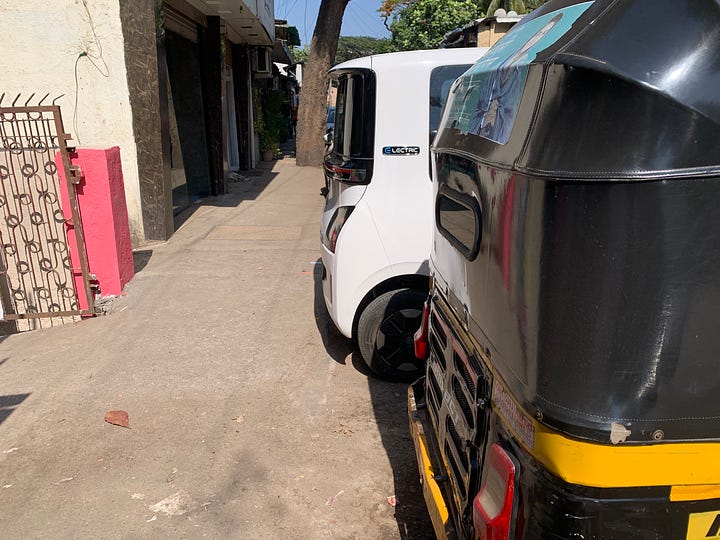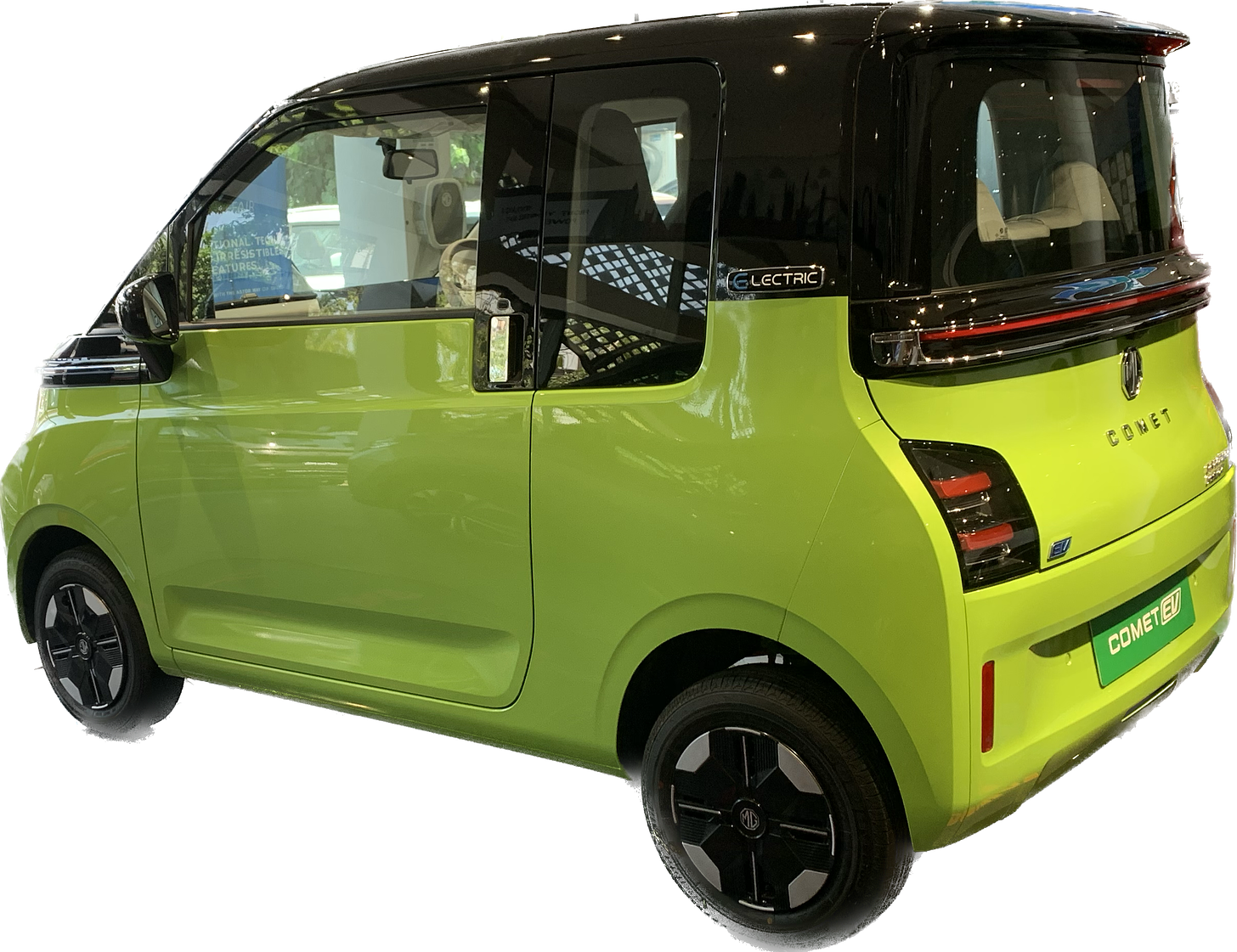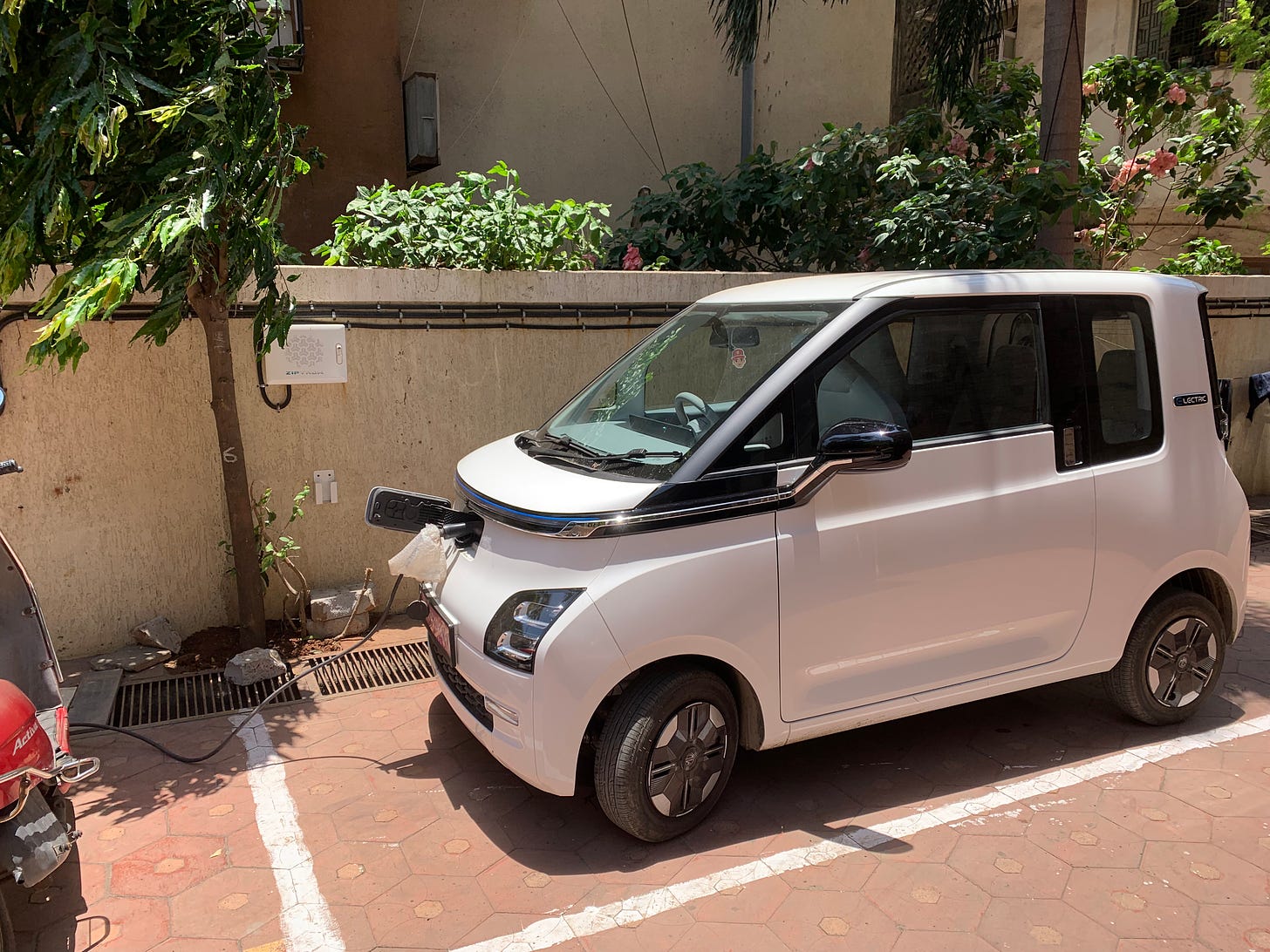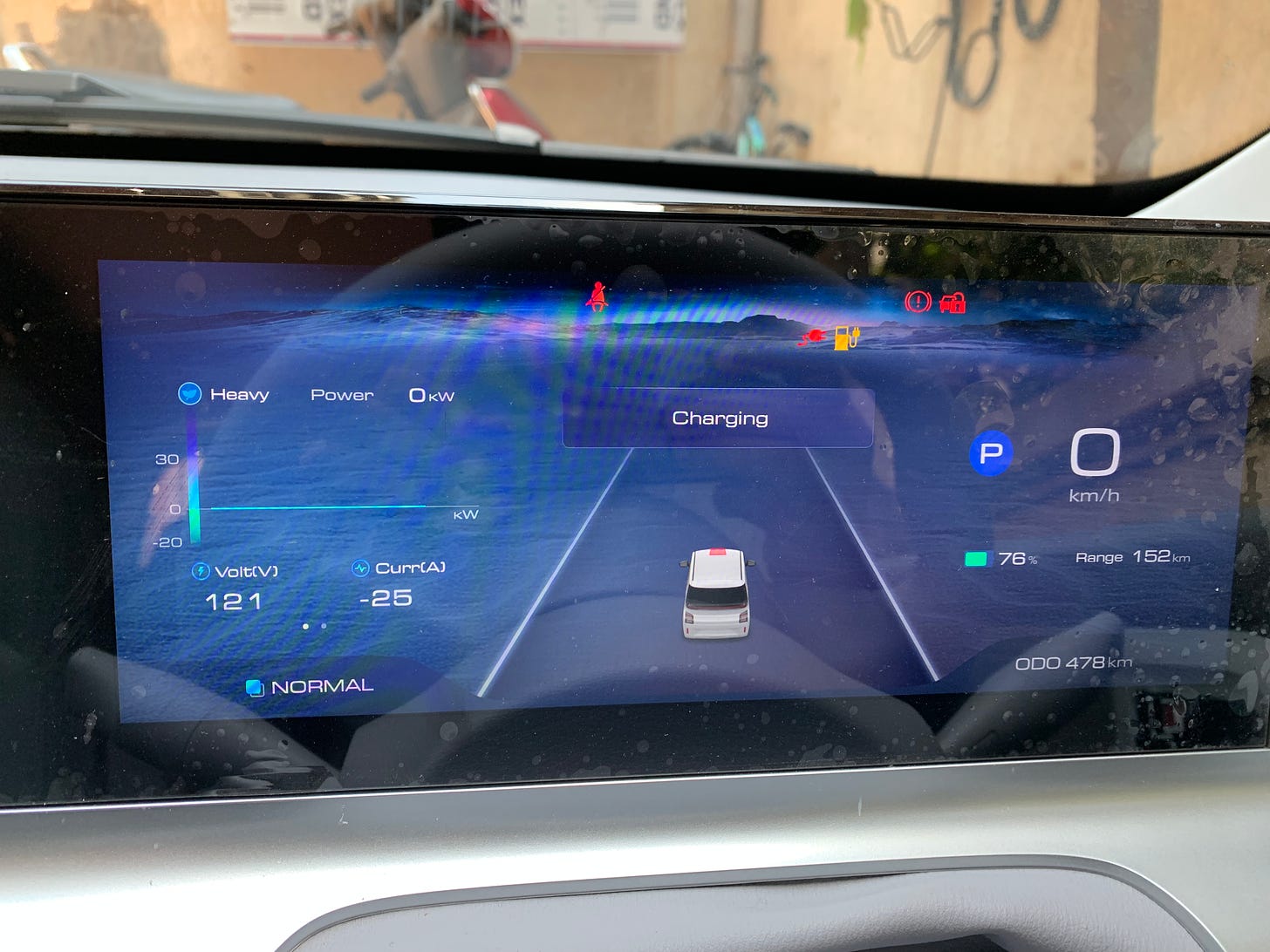Spending a day with MG Comet EV
Range, Costs, Driving experience, Turtle mode and comparison with Tiago EV
I recently had the opportunity to spend a day with the MG Comet EV. My ultimate EV testing guru is Bjorn Nyland. It will take years of testing cars to match his level, but this is a first step in that direction. I focus on aspects like consumption numbers and real world range, and also talk about the looks and driving experience of the car. Join in!
TLDR - Range: 160 km in free flowing traffic with AC on. Without AC, the estimated range is 180-185 km. I compare the car to the Tiago and ZS EV. Even though these two cars aren’t anything like the Comet EV, I have a decent and relatively fresh experience of driving only these two EVs. Pros and Cons at the end of the article.
Housekeeping
I spoke with Awadhesh Kumar Jha of Fortum Charge and Drive India for the TeslaClub India podcast. Here's the link to the audio. We talk in detail about the future of EV charging in India.
I attended an event in Kochi hosted by EVOK and ChargeMod. Subscribe to my blog to know what I learnt there! P.S. : Something very interesting is happening in Kerala!
Let’s go
This post is supported by ActiveBuildings. Get your indoor air quality tested for as low as INR 699/- Why you ask? Here’s why.
Disclosure : I am the cofounder of ActiveBuildings
Charging
MG Motor India handed over the car to me at noon with ~70% SoC. I drove the car from the showroom to my home and plugged the car to charge via my 7.2kW Exicom charger, installed for my ZS EV.
The Comet is based on a 120V architecture. It charges at 3.3kW. Thus the battery is being charged with 25-26A. The battery pack size is 17.3kWh, so to go from 0 to 100% SoC it takes around 5.5h of charging via an AC Type 2 charger. This doesn’t include the cell balancing time.
To give some context, my 2022 ZS EV and Tiago EV both operate on a 400V architecture. In fact, most vehicles globally operate on either a 400V or 800V architecture. Higher voltage allows for the car to be charged at lower current, leading to less power losses.
P (Power), V (Voltage), I (Current), R (Resistance). Losses typically happen due to the resistance in the circuit.
Most fast chargers work best with high voltage architecture. To get higher charging speeds for low voltage architecture, the current would have to be drastically higher, which would make the cables thick and warm. This explains why the Comet doesn’t support fast charging.
The battery capacity of the car is 17.3kWh. Most cars in the Indian market have a charging capacity of 1C or thereabouts. 1C means that the car will charge the battery from 0 - 100% in 1h. 2C would mean that the charging from 0 - 100% will happen in half an hour. Thus, for a 1C rating and 400V architecture, the car would have to take ~43A. The Tiago EV on the other hand can take 50A @ 400V, translating to a 20kW charging speed.
If MG were to add fast charging capacity for the 120V architecture, the car would have to take ~144A to get a 1C rating. For context, MG’s 2022 ZS EV with 50.3kWh battery can take around 150A and costs thrice the price of a Comet EV.
For a car to have faster CCS2 DC charging, additional electrical components have to be added to comply with the global compliance standards. This adds to the cost of the car. Increasing the cost of the car is not feasible given that everyone I interacted with found that the cost of the car to be high. More on costs later in the post.
Look and feel
The elephant in the room. The two door car’s look is polarising. You either fall in love with it or you hate it. But it surely grabs attention. Everyone’s eyes on the road are on you, though this factor will fade in a few months when people start seeing them on a regular basis. Using concrete and scientific measurement techniques, I found out that the Comet EV is only slightly bigger than a humble Mumbai auto rickshaw / tuk tuk.


People say that it feels like you are in an airplane cockpit, but I haven’t been in one to confirm or deny that. I can definitely confirm that the backside window does make you feel like you are in a low cost airline aircraft. It has a fixed window pane with little to no legroom. The happiness of your knees is dependent on your height and the person sitting in front of you. Also, there are no air vents in the back. All in, the shorter the journey the better, if you are seated in the back.
The front two seats have amazing leg room because there is no central console. There aren’t any other auto parts too that come in your way. However, the seat lacks under thigh support and I started missing it within the first hour of driving the car. The car controls are straightforward and the key fob is best in class for the segment.
There isn’t any start or stop button, which is such a thing of the past. Good on MG to implement that. You open the car, it boots up or “switches on”. You exit the car and it “turns off”. I wonder when other legacy automakers are going to make this a standard feature in all electric vehicles.
The steering wheel has minimal controls. Even the trip set / reset is hidden under settings on the infotainment screen. The stocks on the wheel are also minimal. The car does come with wireless Apple CarPlay. That makes up for the lack of conveniently placed USB charging sockets. The wireless CarPlay works like a charm and is sick. The car does miss out on some key features like auto hold and cruise control. Of the two, I missed auto hold more than cruise control while driving it around in Mumbai.
The instrument cluster is good. It has adapted a real time driving graph from the Nexon and Tigor, which I find to be really useful and intuitive. The graph is range limited to 30kW max power and 20kW regen. MG, like in both their cars, love to show the voltage of the battery pack along with the current that it is supplying. The graph is a much better indicator of how you are driving as compared to the Current and Voltage numbers.
The instrument cluster lacks consumption numbers. All other modern EV cars have this number shown prominently in the cluster. It is a good metric to know the car's efficiency. More on this in the next section.
The drive and range
The car does get multi regen mode and multi driving modes - Eco, Normal and Sport. For my test, I topped up the car to 100% and drove it in Normal mode with the highest possible regen. The car makes a loud disconnect sound when the charge reaches 100%. The regen on the Comet EV kicks in at around 96% SoC and is limited to 3kW or 120V and 25A.
There is no auto mode, so I kept the AC on Lo mode with fan speed at 4. The highest fan speed is at 7. In steady state, the car consumes around 600W of energy to cool the cabin. This number is similar / slightly lower to my ZS EV, which consumes around 800W for air conditioning.
The trip meter on the cluster screen didn’t show the efficiency numbers unlike most modern electric vehicles.
I drove in traffic on the Western Express Highway to the Jio Mall in BKC. From there I headed to Powai. While parking at both of these places I appreciated the compactness of the car. You can have plenty of space all around your car when you are parking in a mall, hence less chances of scratches. And when you are parking on the road, the car takes up the space of only two bikes.
From Powai, I headed to the Eastern Freeway to drive at relatively higher speeds of around 75kmph. The car feels stable at high speeds, although less stable when compared to the Tiago or the ZS EV. I would not recommend driving the car at high speeds on steep curves because of the high center of gravity in this car. That makes it feel unstable and feels that it can topple anytime.
I drove all the way from Powai to town and back to King’s Circle for some work. The car had barely dropped to 50% and the GoM showed that it had enough range to drive another 100 km. The GoM on the car is fixed, based on the state of the charge. If the consumption is higher, then the SoC will fall rapidly and so will the GoM. This kind of GoM paired with realtime consumption numbers is preferred because you can always keep an eye out on the SoC to theoretically know how far you can travel. Since the Comet lacks mileage numbers, you can never really know when you’ll run out of charge.
After coming home for the night, I took the car out again for a spin in the morning. I went to Sanjay Gandhi National Park which is roughly 20 km from my house. From there I headed to Versova. By the time I reached Versova, the SoC was 12% with GoM showing 24 km of range left. It was time to take the car back to MG Jogeshwari, which was another 5 km.
As soon as I hit 10% SoC, the AC got cut off and turtle mode kicked in. There was a power limitation of 7kW even after flooring the accelerator. Good luck if you have a steep hill to climb to get to your charger! The car repeatedly asked me to charge immediately. I reached the showroom with 8% SoC. The GoM had disappeared at 10% SoC.
I could drive for 148 km in 92% charge with AC on. Extrapolating, we get a total range of 161 km with AC. The consumption number is roughly 107 wh/km or 9.3 km/kwh. These consumption numbers are slightly better than my Tiago EV which averages around 120 wh/km with AC on in heavy traffic. If I have to estimate, the car will be able to do around 180 - 185 km with no AC in similar conditions.
The car doesn’t have an aerodynamic design. Thus at high speeds, the consumption numbers will be higher when compared to a conventional car. The best way to get low consumption at a low state of charge would be to draft behind any tall vehicle. The air drag will reduce considerably and you’ll be able to make it to your destination.
Cost
The top model of the car costs INR 10L on road or ~ US$12,000. The cheapest one is around INR 8L or ~ US$9,600. The cheapest model with 50% more battery capacity starts at almost half the rate in China at ~US$4,950.
In India, the entry level car should have been priced at closer to INR 5-6L or ~US$6,000 - US$7,200. That would have taken the market by storm. Maybe once MG has localised their entire supply chain, they can afford to sell the car like hot cakes.
Summary
Pros :
Compact car
Great range for city
Wireless Car Play
No Start stop button
Good legroom in the front
Design
Cons :
High price point
No default option to remove the backseat to make it a 2 seater car
Slow charging
Power limitation and AC cutoff under 10% SoC
Design
I would like to thank the staff at MG Motor India / Krishiv Motors, Jogeshwari for allowing me to test the Comet EV for the day.
This piece can be re-published (CC BY-NC-SA) with a line mentioning ‘This was originally published on ExpWithEVs Substack’ and a link back to this page. In case of re-publishing, please alert priyansevs@gmail.com
Text and data - Priyans Murarka
Editing - Siddharth Agarwal












Really a detailed review!
Thanks a lot, i especially loved the technical side of article,it's informative and at the same the illustrated in a way everyone can understand easily❤️
A good post. Unbiased view which a prospective EV user would like to factor in their decision making. It would have been good to drive the vehicle with all four persons sitting in car. That would have shown how efficient is this as “Family Car”.